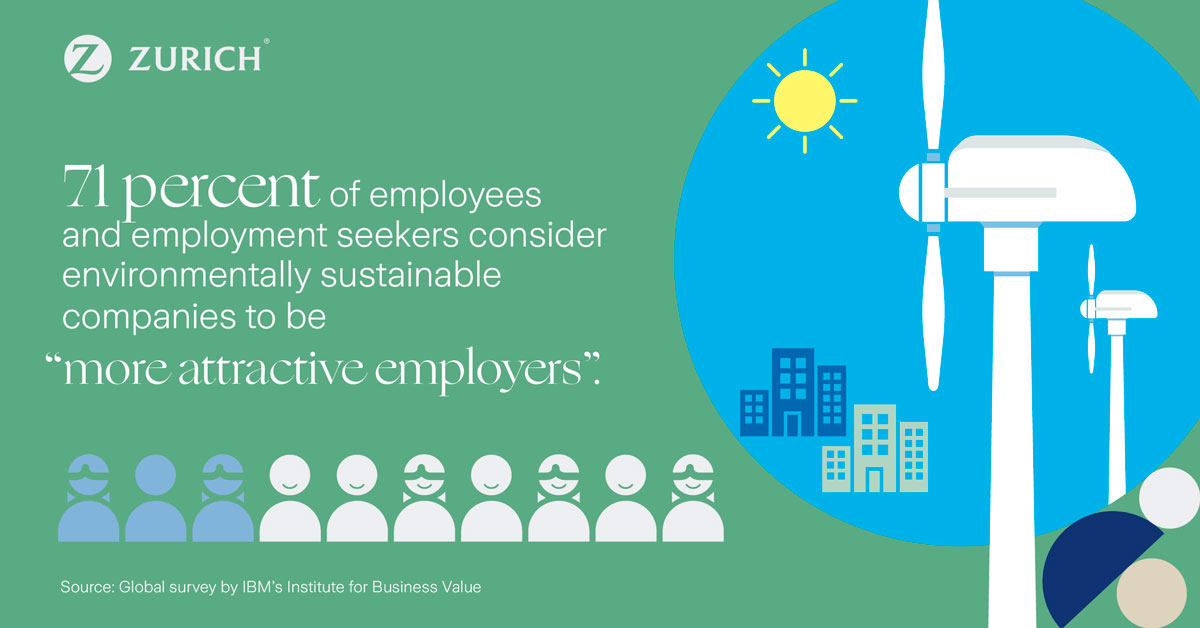5 ways companies can inspire their staff to act on climate change
Climate resilienceArticleSeptember 1, 2021
Companies everywhere have a vital role in meeting the challenges of climate change. Here are five ways your business can inspire employees to make a meaningful difference
Going green – and confronting the immense challenges presented by climate change – has never been more important for companies. Customers want it. Government regulators demand it. And investors increasingly value it.
A recent global survey by IBM’s Institute for Business Value found that 71 percent of employees and employment seekers consider environmentally sustainable companies to be “more attractive employers”. In fact, nearly half of those surveyed said they would accept a lower salary to work for an organization with a genuine commitment to the planet. Clearly, employees are becoming increasingly motivated by green issues.
As Linda Freiner, Group Head of Sustainability at Zurich Insurance Group (Zurich), explains:
“The pressure for companies to embrace sustainability is coming from all sides. But by setting an example on climate action there is also a huge opportunity for them to engage in a positive way with their staff – many of whom already feel passionately about this issue.”
So how can companies seize this green opportunity? Here are five ways companies are inspiring their staff to act on climate change.
1. Sustainable commuting
Globally, transport accounts for about 16 percent of all greenhouse gas emissions. Commuter journeys contribute a remarkable proportion of these emissions, especially in countries with large, urbanized populations. In the UK, for example, commuting accounts for 15 percent of all journeys and 20 percent of the total distance traveled each year. So, if companies are serious about helping their employees reduce their carbon footprint, the best place to start is with their daily commute. There are a number of ways to do this:
- Electric cars – EVs emit around a third of the CO2 of petrol vehicles, depending on the amount of fossil fuels used to generate the electricity. And their numbers are growing fast: there were about 17,000 electric cars on the world’s roads in 2010; today there are more than 10 million. By installing EV charge points at the office or by switching corporate fleets to go electric, companies can help accelerate this encouraging green trend.
- Carpooling – car sharing initiatives have a two-fold benefit because they reduce emissions and traffic congestion simultaneously, an urgent priority in heavily congested cities such as New York, London, Seoul, and Shanghai. Siemens, Amazon, and Infosys are just three of a growing number of companies urging their employees to use carpooling services for their daily commute.
- Public transport – another greener alternative to single occupancy car journeys is public transport. According to the UK government, travelling on a light railway or the London Underground metro system emits around a sixth of the emissions of the equivalent car journey. Companies can play an active role in prompting staff to take the train or bus. For example, Zurich has deliberately not built parking spaces at its new Quai Zurich Campus headquarters so that employees are encouraged to take a greener route to the office.
- Cycling – the most sustainable (and healthiest) way to get to work. Governments are encouraging commuters to cycle by introducing segregated cycle lanes, but companies can do their bit by providing secure bike storage, offering tax-deductible bike-purchasing schemes, and installing charge points for e-bikes. E-bikes have the potential to revolutionize the daily commute. In one of Copenhagen’s new ‘cycling superhighways’, for example, the average cyclist’s commute is now 15 kilometers, largely thanks to e-bikes. E-bikes’ environmental credentials are excellent: after factoring in the CO2 emissions produced to generate the electricity, an e-bike’s carbon footprint is 2.6 grams of CO2 per mile. This compares to 150 grams for most electric cars and 136 grams for scooters.

2. Working from home
The ultimate way to reduce emissions generated by your daily commute is, of course, not to set off in the first place. Analysis by the International Energy Agency (IEA) found that for people who commute by car, working from home is likely to reduce their carbon footprint if their journey to the office is longer than 6 kilometers. The IEA also found that if everybody who is able to work from home globally did so just one day a week, it would save around 1 percent of global oil consumption for road passenger transport each year.
Even taking into account the increased use of household electricity, the overall impact would be an annual decline of 24 million tonnes of CO2 – equivalent to the annual emissions of Greater London. The COVID-19 pandemic has forced millions of people to work from home. A simple but highly effective way for companies to help the environment is to allow the flexible working trend to continue.
3. Reduce wastage in the workplace
If companies are going to trumpet their green credentials to their customers, they must ensure their own offices are managed in an environmentally responsible way. The most effective way is to ensure all buildings are properly insulated to the highest standards, and built from sustainable materials that are low carbon, or recycled and recyclable. Well-designed new buildings can be zero-carbon, requiring no heating or cooling, dramatically reducing emissions and operating costs.
Further energy and emissions reductions can come from installing motion-sensitive light switches to posting notices encouraging staff to take the stairs instead of the elevator, small things can make a tangible difference. IBM, for instance, has managed to save more than 5 percent of the company’s total energy use by working with its staff on a decades-long energy conservation program. Other companies, such as IKEA, have gone a step further by installing solar panels to power their stores with the aim of becoming a net energy exporter. While by introducing measures to conserve electricity and water, and encouraging reuse and recycling, Accenture has more than halved its CO2 emissions per employee.
By setting the highest standards in the workplace, companies can support staff to transfer their environmentally friendly habits from work into the home and make a significant difference to their personal carbon footprint.

4. Hero projects that make a difference
Reducing day-to-day energy consumption and increasing reuse and recycling encourages employees to think small. But major green initiatives can inspire them to think big, firing their imaginations and helping them feel part of the global solution. BASF, for example, invited its staff to nominate corporate volunteering projects in one of the company’s three core areas of food, smart energy, and urban living. After employees voted for their favorites, 150 were selected, ranging from projects providing clean drinking water in Africa to supporting beekeeping in North America.
In a similar vein, Zurich Insurance Group promotes its own environmental project in Brazil, the Zurich Forest Project, in collaboration with the non-profit organization Instituto Terra. Through this pioneering green initiative, Zurich has sponsored the planting of one million seedlings of up to 120 selected native species, supporting the growth of a healthy native forest.
As well as having a significant positive impact on local biodiversity and the environment, Zurich also uses the forest as a tangible example of climate action to share with colleagues. All 55,000 Zurich employees are encouraged to attach their name to a tree and become a custodian of the forest. They are provided with regular updates, such as photos of wildlife returning to forested areas and stories about the importance of preserving such ecosystems for future generations.
5. Build sustainability into the brand
We have looked at specific actions that companies can take to incorporate sustainability into what they do. But perhaps the most profound impact can be achieved when companies incorporate sustainability into who they are. To do this, a company's stance on green issues must become synonymous with their brand. The clothing company Patagonia, for example, has created a series of brand adverts encouraging people not to buy new things and to repair old ones, including their own products. Unilever has made sustainability part of its corporate identity, even including it within the company’s updated logo. Encouragingly, Unilever found that its Sustainable Living Brands, which are the parts of the company “taking action to support positive change for people and the planet”, grew 69 percent faster than the rest of the business and delivered three quarters of Unilever’s overall growth. This in turn has led to a widespread adoption of sustainability among the company’s employees, with 76 percent saying their role at work enables them to contribute to delivering on the sustainability agenda, with around half of all new employees citing Unilever’s ethical and sustainability policies as the primary reason for joining the company.

This highlights an important point: that to truly incorporate sustainability into their brand, companies need to find a way to combine environmentally friendly action with commercial success.
As John Scott, Head of Sustainability Risk at Zurich, explains:
“Companies can play an important role in addressing climate change, but they have to do this by building sustainability into their core business. The most successful companies are those whose sustainability values are built into what they do for their customers and employees. They delight their customers and attract and retain employees because they not only do good, but they are commercially successful too.”
Further information




